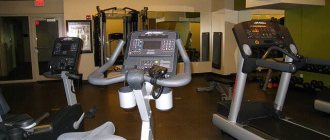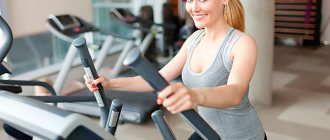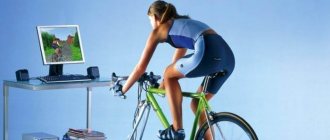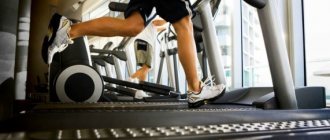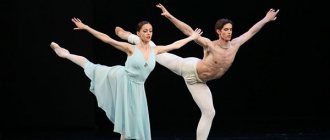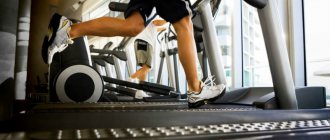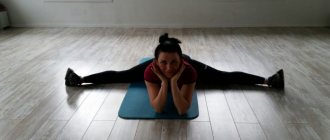Author: Kristina Lobanovskaya, doctor, practicing nutritionist Article updated: 11/10/2020
Step, translated from English as a step. From this it is easy to understand that step aerobics is a type of sport based on performing various steps on a special platform, which are accompanied by additional movements. Usually these are dance elements that are done at a fast pace. It was developed about 20 years ago by an American fitness instructor, Gina Miller, when, after a knee injury, she needed a set of exercises to restore tendons.
Today, this area is used not only by athletes, for rehabilitation after injuries and preparation for heavy loads in competitions. Step aerobics has reached the masses: it is practiced in gyms and at home to improve the health of the body and lose excess weight.
What is step aerobics
According to recent surveys and studies in the field of fitness, step aerobics is one of the most popular areas of group exercise. People are attracted by the dynamism of the workout, the simplicity of the exercises, and the versatility of the complex. With the help of step you can not only develop endurance, but also transform your body. Understanding the features of step aerobics, as well as what benefits a well-designed complex will bring to the body, the athlete will be able to draw a conclusion about the effectiveness of this area of fitness. In addition, having an idea of how such training programs are put together, it will not be difficult for a person to independently create a training plan for himself.
What it is
Step aerobics as a fitness trend began to develop in 1989.
Initially, such activities were recommended for people with disabilities in sports due to previous injuries. And only around the 2000s, step aerobics experienced a new round of development. Now training of this kind is considered the most effective due to an integrated approach to constructing an algorithm for performing exercises. (1) Activities of this kind involve the use of a special sports device, a step. It is a plastic step, the height of which is adjusted depending on the purpose of the training and the individual characteristics of the person.
Features of this type of fitness
This type of fitness has a number of features that must be taken into account before starting step aerobics classes. These include:
- no need for large financial investments before starting training at home;
- simplicity of basic exercises, which does not require special skills and a high level of physical fitness;
- the ability to strengthen the heart muscle, while pumping muscles and losing weight;
- the presence of several types within the direction, differing from each other in the intensity of the classes, as well as the focus of the exercises themselves included in the complex.
Benefits for the body
The vast majority of athletes who regularly engage in step aerobics note positive changes in their body, including:
- stabilization of blood pressure;
- improving the mobility of joints and the skeletal system;
- effective training of muscle groups that are not used during regular training;
- comprehensive pumping of the muscles of the whole body;
- minimizing the risk of excessive “drying” of one zone, disturbing the proportionality of the athlete’s body;
- improvement of mood and general well-being.
Important! If there is a desire to lose weight, thanks to the type of fitness under consideration, the athlete must not only exercise regularly, but also monitor his diet and lifestyle in general.
What is good for children
Step aerobics is one of the few areas in sports that are universal. It can be practiced not only by adults with insufficient levels of physical fitness, but even by children.
Summarizing
Absolutely anyone can do step aerobics. There are no restrictions on age, gender, or level of physical fitness. The main thing is to correctly assess your strengths, gradually increasing the load. You should also take into account the contraindications that were described in the article. Step aerobics allows you to lose weight, improve your well-being, strengthen bone and muscle tissue, as well as your heart. Three one-hour workouts per week are enough.
STEP AEROBICS for BEGINNERS lesson 1 of 30 on timestudy.ru
Igor September 26, 2021
Names and descriptions of steps
The most common types of steps used in step aerobics are:
The order of placing the feet on the step: right, left; toe-off from the projectile: right, left.
The technique and sequence of stepping the legs onto the platform are similar to the basic version. The only difference is that in this case the foot must be placed on the corresponding angle of the step surface (right to right, left to left), and not in the center, as in the first point.
Over step
You need to start moving by standing with your right side to the platform. The sequence of changing the position of the legs: right up, left up, turn with your back in the direction of movement, right down, left down. After this, you need to take the IP, positioning yourself with your left side to the step, and repeat the exercise in a mirror manner.
Knee Up
Step your right foot to the left corner of the step, and then transfer your weight completely to it. Then you need to raise your left leg, pulling it towards the supporting limb, bending it at the knee. At the final stage, the left leg comes down from the platform first, and then the right.
Step kick
The technique for performing this step is absolutely identical to the previous one. However, in this case, the second leg does not just pull itself up to the supporting leg, but kicks it in the air.
Flywheel (Step lift)
Step onto the left corner of the platform with your right foot. Having transferred the main part of the weight to it, without bending, place your left limb. The latter, while maintaining the position, must perform 3 multidirectional swings: forward, sideways, backward. After this, the left leg lowers to the floor and, becoming a supporting leg, pulls the right leg towards itself.
Set of exercises
There are many sets of step aerobics exercises: short and long, for training of any complexity and intensity. However, to begin with, it is better to choose simple exercises that provide a good load on all muscle groups.
Perform each set of movements 16-20 times.
1. Stand straight, feet shoulder-width apart, arms at your sides. Bend your knees and elbows slightly. Perform side steps alternately with both feet. At the same time, move springily and each time, connecting your legs together, raise your arms forward to chest level.
Now do the same, but do not spring when walking, but glide.
2. Add a complicating element to the same exercise: perform two side steps as before, and on the third, try to reach the buttock with the heel of the side foot. Do repetitions of the ligaments for springing and sliding steps.
3. Now do everything as in the second exercise, only instead of sweeping your leg back, raise your knee as high as possible to your chest.
4. For the next exercise, stand with your feet together and your elbows bent. Perform simple springy steps, raising your knee up, in this way: two steps in place, the third wide, to the side, 4 steps in place with legs wide apart, an additional step with the second leg and a double step in place. In other words it looks like this:
- in place, legs narrower than shoulders – right, left (1,2);
- right, wide step to the side (3);
- steps in place, feet wider than shoulder width - left, right and again (1,2,3,4);
- attached left, he is the first in place and the second, right (1,2);
- left, wide step to the side (3).
- And so on.
5. Now change the position of your feet - wider than your shoulders. Jump onto the bench with both feet, slightly springing. Step off the platform with one foot first, then the other.
6. From the same starting position, lunge forward wide with one leg, placing your entire foot on the board. Lower yourself to the bottom position. Then stand back up and repeat the exercise on the other leg.
7. Stand on the platform facing the short side. Dismount with one foot, as if “stomping” on the floor. Bring her back to the bench. After this, repeat the exercise on the other side.
How to move correctly
You need to perform the exercises not only by walking and moving your arms and legs correctly, but also by observing the execution technique. There are basic rules for body position and movements:
- When performing steps on a bench, place the entire sole of your foot on it;
- keep your back straight;
- do not swing your legs and arms too much: the emphasis should be placed not on the sharpness of movements and “higher, stronger”, but on working the muscles;
- take steps using the muscles of your legs, not your back.
Don't forget that during training you sweat a lot and lose fluid, so you need to have a small bottle of water with you.
Program options
The step aerobics program should be drawn up depending on the physical fitness of a particular athlete.
For beginners
- Warm up.
- Walking in place – 5 minutes.
- Basic steps – 2 minutes.
- Step accompanied by a kick – 2 minutes.
- High knee step – 2 minutes.
- Step with triple knee lift at one point - 1 minute.
- Step with clap and straight leg swing – 2 minutes.
- Step with leg bending back – 2 minutes.
- Repeat point 7 – 1 minute.
- Step with a swing to the side - 2 minutes.
- Repeat point 7 – 1 minute.
- Stepping onto the steppe with the straight leg moving back – 2 minutes.
- Cool down with restoration of breathing frequency.
For experienced athletes
- Warm up.
- Side step from side to side – 7 minutes.
- Step to the side while simultaneously touching the surface of the step with the opposite foot – 2 minutes.
- Basic steps – 2 minutes.
- Basic diagonal step with clap - 2 minutes.
- Knee step – 3 minutes.
- Repeat point 4 – 2 minutes.
- Double rearrangement of the leg sideways, without lifting it from the surface of the steppe, 4 minutes.
- Repeat step 5 – 2 minutes.
- Crossing the platform sideways with a jump at the top – 4 minutes.
- Repeat step 4 – 2 minutes.
- Crossing the step sideways with knee lift at the top point – 4 minutes.
- Basic walking with a gradual decrease in the tempo of the exercise - 1 minute.
- Cool down with elements of breathing exercises.
Equipment for classes
To feel comfortable during training, you need to dress properly and also have the necessary sports equipment. If you are working out in a group, then the fitness club already has step platforms, but for home exercises it is better to purchase professional “steps” than to use improvised material.
Step platform
Photo: https://www.flickr.com/photos/ [email protected] /8668679447/ A modern “stepping platform” is manufactured to be stable and safe.
It is made of durable plastic, and covered with an anti-slip rubber coating on top, which is necessary for shock absorption and stability. The length of the platform is 80-120 cm, width is 35-40 cm, and the height can be adjusted in three levels. Depending on the manufacturer, the height levels are:
- 10-15 cm;
- 15-20 cm;
- 20-25 cm.
Clothes and shoes
As noted above, step training should be carried out only in sneakers that provide good support for the ankle joint. They will protect him from possible injuries, sprains and dislocations.
It is recommended to give preference to special running shoes because:
- they have a good springy sole;
- there are ventilating inserts that provide “breathing” to the legs;
- under the heel and on the foot there are special “pads” filled with air for a shock-absorbing effect and softening impacts on the surface.
As for clothing, it should be comfortable and convenient. Since you will be doing physical activity, choose breathable fabrics made from natural materials. It is advisable to avoid long and wide sweatpants to avoid stepping on the pant leg during exercise.
How do we lose weight? Is step aerobics suitable for weight loss?
Step aerobics for weight loss is an ideal choice, provided that the workout lasts more than half an hour and you watch your diet.
In order to answer this question, you must first understand the mechanism of weight loss itself. A person loses weight at the moment when the amount of energy he expends exceeds the amount he receives. This is simple mathematics and the statement is quite obvious.
You spend a lot of energy in class, and we can conclude that any type of aerobics for weight loss is simply ideal. Step aerobics is no exception. But if everything were so simple, thousands of women would not be tormented by the question of why they attend training regularly, but the weight does not come off.
Our body receives energy from food and distributes it for its own needs. What remains “extra” is put aside in reserve. Energy resources for different needs are formed by the body in different forms.
There is a certain reserve of energy that the body always keeps, as they say, “in quick access.” What if you urgently need to climb the stairs to the tenth floor or run a hundred meters.
This energy reserve, which helps quickly mobilize your strength, is stored in the form of carbohydrates (glucose, glycogen) in your muscles. This reserve is enough for 20-30 minutes of intensive work.
When you have spent this resource, but by force of will you force yourself to continue training - nothing can be done, the body has to extract energy from more valuable resources - fats. Accordingly, you begin to lose weight after half an hour of intense step aerobics.
I will not focus on the fact that step aerobics training for weight loss needs to be continued for more than half an hour, since the standard training time in a fitness club is 45-60 minutes. Of course, if you study at home, make sure that you have enough time to fully study.
So, you left the hall, came home and sat down to eat. The body has replenished the spent reserves of carbohydrates. You continue to eat - the reserve of carbohydrates is full, excess energy is stored by the body in the form of adipose tissue. Everything you spent today was immediately restored.
This is where we came across the second reason preventing you from losing weight by doing step aerobics. Of course, step aerobics is effective for weight loss, but without an appropriate diet it is unlikely to achieve results. The situation seems kind of hopeless, doesn't it? And how can you understand how many calories you spend during training and how you can build your diet. More on this later.
Myth 3. It’s better to exercise every day
In fact, every day you should not train, but move. That is, walk up the stairs, walk in the park, walk a couple of bus stops, or simply clean the apartment. But between workouts - really intense movement, when you sweat and your heart rate increases noticeably - there should be breaks.
A professional athlete needs half a day to recover, but you and I need a day or even two. When the body rests, it redistributes internal resources. It grows muscles, restores hormone levels and spends energy on this... Yes, yes, from fat reserves! If you don’t have time for this process, you will start training with force, get tired quickly and, worst of all, burn not fat, but just muscle, plus you will greatly increase the risk of injury.
How many calories does step aerobics burn?
Energy costs are traditionally expressed in kilocalories. Calorie consumption when doing step aerobics depends on your weight (the heavier the body, the more energy is spent on moving it), as well as on the intensity of the activity, age and some other factors.
Well, on average, how many calories does step aerobics burn, you ask? The answer is below.
- Low-intensity step aerobics. You take steps and do exercises, but at the same time you can talk calmly (breathing is not interrupted). In this case, step aerobics burns hardly more calories than vigorous walking. That's about 250 calories per hour. In this case, you are unlikely to be able to lose weight with aerobics, or you will succeed, but very, very slowly. It’s better to pull yourself together and try to give your best during class.
- Medium-intensity step aerobics. You try to repeat everything after the trainer, take energetic steps, sometimes jumps, you can say a couple of sentences, but this is already difficult - your breathing becomes difficult. With such exercises, step aerobics for weight loss is much more effective. In an hour you will spend about 350-400 calories.
- High intensity step aerobics. You fly around the step with great speed, make jumps, add movements with your arms. Congratulations, at this intensity of training you will burn about 500 calories. However, if you exercise actively and regularly, the question “does aerobics help you lose weight?” most likely not in front of you.
Now, knowing how many calories are burned during aerobics and adding your usual daily energy expenditure, calculated in accordance with your lifestyle, age and weight, you can plan your diet and deal with the second factor preventing you from losing weight - excess calorie nutrition.
But be careful. In order for weight to begin to go away, it is enough that the caloric content of daily food taken is 20% less than required, but no more.
In conclusion, I will say that the effectiveness of step aerobics for weight loss is associated not only with energy consumption. Step aerobics classes have a positive effect on metabolism, which is also an important factor in helping you become slim.
TRX
In one session on TRX you can burn from 200 to 450 calories. It all also depends on the duration and intensity of the workout. If you exercise on TRX loops for about 30 minutes, you can burn 200-250 calories. We told you where to practice TRX in Kyiv in our selection of top 5 clubs.
Step aerobics for weight loss
Step aerobics is a set of dance steps that are designed to help you lose weight and gain an athletic body shape. The best thing about this type of fitness is that it does not require too many equipments and accessories. All you need is a stable bench or step platform, as well as a pair of quality shoes - and you're ready to practice! Step aerobics complexes for weight loss, the videos of which you will see below, include a wide range of exercises from simple ones intended for beginners to intense ones aimed at advanced athletes.
Myth 5. You need to find a suitable training program and always follow it
Alas, even the most wonderful type of exercise cannot be used for a long time. The body adapts to the load within 4-6 weeks, and training needs to be changed. If you've been running, try running faster, or skiing, or alternating running with dancing. If you have danced, try other types of dancing or the pool. If you have been doing callanetics, alternate it with cycling. In strength exercises, change dumbbells to expanders and vice versa, try new exercises, add the number of repetitions. Make changes as soon as you feel that your workout has become noticeably easier.
What are the contraindications for doing step aerobics?
Step aerobics for lovers of active sports
Step aerobics is a newer version and technique of aerobics, the main difference is that in step aerobics the exercises are performed in a horizontal position rhythmically. In step aerobics, it is important to pay attention to your posture and how you step. The body and shoulders should be straight. The knee should never bend more than 90 degrees (that is, keep the knee at a right angle), and at least 60 degrees is better.
Step-aerobic is quite popular: many people prefer “stepped” classes to regular aerobics. However, if you have knee or ankle problems, step aerobics may not be the best choice for exercise due to the constant stress on your lower extremities.
Safety precautions
Effective exercise is possible only if safety precautions are observed, following the rules:
- Step aerobics is carried out only if the person losing weight is in normal health;
- If an injury occurs during an exercise (muscle strain or dislocation), you should immediately stop aerobics;
- The inventory must be in good working order;
- It is necessary to maintain water balance to avoid dehydration;
- During a hunger strike and strict diets, it is better not to exercise;
- Improper exercise technique can harm the musculoskeletal system.
Benefits of step aerobics
- Step aerobics is effective for losing weight.
- A set of exercises with low loads and amazing results.
- Helps burn a large number of calories.
- Accelerates the process of weight loss.
- Tones many large muscles in the body.
- Increases body flexibility over time.
- Helps improve coordination as well as endurance.
- This sport can be practiced at home.
Simply achieve sporting success with dance aerobics
Aerobic exercise is an important part of a well-designed workout. Many exercises are designed to train cardiovascular endurance; step aerobics is one type of such training.
Step aerobics gained popularity in the 80s of the 20th century. and it is still one of the popular types of fitness due to intense workouts that allow you to quickly lose weight at home. This type of fitness is an effective way not only increase endurance and burn fat , but also improve your mood.
Step aerobics is easy to learn at home. All you need is a pair of comfortable sneakers and a step platform . You can use another elevation, but we recommend that you still pay attention to a professional platform, because... it is stable and not expensive. Using other elevated positions, such as benches, poses a risk of injury.
History of creation
Thirty years ago, American Jean Miller, who leads fitness classes for those who want to lose weight, injured her knee. He was cured, but in order to strengthen the leg muscles after the injury and restore motor functions, the orthopedist advised the girl to go up and down the stairs as often as possible. It was very important for Jean to return to work, so she trained every free minute.
The first “exercise machines” for her were the steps of the porch, as well as a milk crate, which she used for training at home. It was boring to do monotonous movements, so Jean began to turn on music and tried to move to its rhythm. In a short time, the knee joint was restored, and Jean Miller developed a new fitness program to keep her body in good shape.
Translated from English, the word “step” means “step”, which is exactly how the new direction in aerobics was named.
Already in the mid-nineties, more than nine million Americans and the same number of people in other countries were engaged in a new type of fitness. Step aerobics was rapidly gaining popularity and is still practiced today.
Is it possible to lose weight by doing step aerobics at home?
What could be better than feeling skinny?!
Burning calories is definitely a positive effect of step aerobics. A study published in the International SportMed Journal examined the effects of step aerobics on obese women who were primarily sedentary. Upon completion, researchers from the University of Aksaray (Turkey) found that after 2 months of moderate exercise, all women in the group lost an average of 3 kg. When combined with strength training and a healthy diet, step aerobics can be an effective way to reduce body fat.
How many calories are burned
Step aerobics allows you to effectively burn calories and quickly lose weight with the right approach. If a person weighs 70 kg, then in one intense workout of 60 minutes , you can burn up to 605 calories .
How often should you exercise
Adults should exercise for at least 30 minutes 5 times a week, as long as it is moderate intensity exercise. Or 20 minutes 3 times a week, subject to high-intensity exercise. 150 minutes per week or 60 minutes (high intensity) is the minimum load if you want to lose weight.
Reviews and results of losing weight
Marina, 24 years old
Recently I have gained quite a lot of weight and, as usually happens, I realized it at one point. After a week of depression, I decided it was time to take charge of myself! I scoured the Internet: I looked for information about different sports, read reviews about what to do to lose weight.
In the end, I decided to do step aerobics at home, because I like to dance and move actively, but I hate sports clubs and gyms - it seems to me that everyone is looking at me there. I bought the simplest platform and started practicing: first according to the descriptions, and then with videos or just music.
The effect appeared after 2 weeks - I lost a couple of kilograms. Now I have already lost 7 kilos and have almost returned to my previous shape, but I am not going to stop there, since I am already accustomed to daily exercise and the mood that it creates for me.
Elena, 37 years old
I have been fighting excess weight almost all my life with the help of diets: I lose pounds by restricting myself in food, and then gain them back again when I return to a normal diet. I somehow didn’t think about playing sports, since I don’t have much free space at home and don’t have time to go to the gym.
At the next moment, thinking about how to lose 5 extra kilos, I found reviews of people losing weight with the help of step aerobics. Many girls wrote that they exercise at home and lose 1-2 kilos in a week or two. After much hesitation, I decided to try it - I bought a board and downloaded a course of lessons. But I also went on a diet, just in case.
I removed my excess fat in less than a month and continued working out. True, now I go to the gym - I managed to find time, and it turned out that I like it. I haven’t gained weight for 4 months now, and I’m even losing it a little. So the diets are over now!
Anya, 28 years old
After the birth of my child, I gained more weight in 2 years and did not know how to get rid of it. When my son went to kindergarten, I decided it was time to pull myself together and signed up for step aerobics classes.
At first I went to the gym 2, sometimes 3 times a week - as it turned out, but then, having dropped a couple of sizes, I increased the number of workouts to 4. Now I’ve almost returned to my figure, the way I was before giving birth and I’m very happy. But I don’t want to quit classes - they make me feel more active and beautiful.
What beginners need to know
Remember the basic rules of step aerobics
Like all other forms of fitness, step-aerobic exercise must also be practiced with proper precautions. Otherwise, you may injure yourself.
So here's the checklist:
- Make sure you wear quality shoes that won't cause your feet to slip or become deformed.
- Before starting your workout, warm yourself up by warming up for 10 minutes to relax your muscles and get your heart rate up. We recommend stretching exercises for the legs and hips.
- Place the bench on a completely flat surface and start with the most basic step-aerobic level, gradually increasing the intensity .
- When you take a step, make sure that your foot is fully placed on the step platform.
- Maintain an even posture throughout your workout. Keep your back straight, your shoulders relaxed , and your abs tight to avoid all types of injuries.
- Drink water regularly, especially before exercise, to prevent dehydration.
How to choose shoes
Naturally, sneakers are required for sports. The main requirement for them is that the shoes must be comfortable and not slip. However, if you want to avoid pain and fatigue in your feet even during intense exercise, then pay attention to other characteristics of the sneakers.
Under no circumstances should you try to exercise in sneakers or other semi-athletic shoes. Its cushioning and flexibility are not enough to provide normal conditions for your feet and safety for you during active movements.
Basically, 2 types of sneakers are suitable for step aerobics.
For walking and athletics
The main feature of such shoes is their lightness. Sneakers should not be massive and add weight to your feet. But cushioning is equally important: make sure the sole flexes well. At the same time, both springs and air cushions can be built into it.
These sneakers are suitable for beginners whose entire training so far boils down to doing a series of steps. They will allow your legs to gradually get used to the load and prevent injury.
For fitness
These shoes have good cushioning in the toe area and an adapted design: higher sides and a groove on the inside of the ankle. Sneakers of this type are more like closed shoes: they are not particularly textured and have a padded toe.
These shoes make it easy to perform any exercise and are ideal for intense aerobics.
Video lessons of step aerobics that can be performed at home for weight loss
Step aerobics is more than just stepping up or down. With a well-chosen step aerobics video program for beginners, you can manage your weight, tone your muscles , and even burn up to 10 calories per minute.
Regular exercise will provide cardiovascular and muscular endurance. Involving the upper and lower extremities in the work simultaneously develops coordination and dexterity . Constant exercise will increase leg strength. Plus, you can increase the intensity of your workouts even more by adding weights.
Fat burning leg workout - 12 minutes
This explosive short workout is an effective combination of cardio and plyometrics (jumping training). Includes a large number of jumps, squats, side lunges aimed at training the buttocks and thighs . If you're a runner, this workout is a great cross-training workout to add more energy to your legs and increase your running speed.
Quick Calorie Burn for Beginners - 20 Minutes
Step-by-step training is intense and strictly time-bound . At the same time, it is flexible enough to tailor the exercise to suit you if you are a beginner. You can use additional weights in your hands or perform the exercise without using your hands.
High Intensity Interval Training (HIIT) - 30 minutes
A full-fledged interval workout in which you use both cardio and strength training with weights . The class begins with 8 minutes of cardio before moving on to the strength phase. Be sure to warm up and cool down well for this workout.
Cardio and strength training – 40 minutes
This 40-minute workout includes a combination of upper and lower body cardiovascular strength exercises . The procedure consists of two different complexes of 10 minutes each, which are repeated twice. That is, only 4 approaches of 10 minutes. Each approach is followed by a short break.
Extreme step
A set of quick aerobic step workouts that you can do at home, combining rhythm and vigorous aerobic exercise. The video shows step aerobics exercises for weight loss at one-minute intervals, which are constantly changing and include jumping, squats and jumping lunges . Some exercises will require additional weight.
Kinds
The main characteristic of step aerobics is the dynamism of training, which is based on steps and climbing steps. At the same time, there are many combinations of basic steps, each of which is aimed at working a separate muscle group. In a properly constructed complex, the whole body receives the load. But which muscles work the hardest?
Basically, the exercises are aimed at working the muscles of the lower leg, inner and outer thighs, buttocks, abs and lower back: that is, the lower part of the body. Thanks to this, classes allow you to lose weight and sculpt your figure, without gaining muscle mass.
Although what kind of body you get as a result depends on the chosen direction of step aerobics .
- Basic step. It is built on the use of combinations of basic steps and simple choreography, making it ideal for beginners and people who are not used to physical activity. Moreover, even here there are creative and very interesting combinations of movements that allow you not only to strengthen your muscles and develop endurance, but also to fall in love with this direction once and for all.
- Combined step. It is suitable for people who are not new to physical activity: hardy and active. Here more complex choreography and multi-component movements appear, which are performed to fast and fiery music. More muscles are involved in the work, and the load on the upper body also increases.
- Interval aerobics. The simplest description of this direction is: a combination of step and strength training. However, in reality, everything is much more complicated: providing a strength load can be expressed either in the simple introduction of weights, for example, dumbbells, or in a change in activity. Thus, step aerobics is often combined with bench push-ups and various exercises on it.
In any case, interval training is most effective for active weight loss and modeling an athletic, toned body. However, they are not suitable for beginners: the pace of classes is very high, and only experienced gym-goers can cope with it.
How to do aerobics to lose weight and get rid of cellulite
Aerobics helps to get in shape and maintain health. Regular exercise saturates the body with oxygen, training the lungs and increasing their volume, strengthening the skeletal system, increasing immunity, fighting diseases of the cardiovascular system, lowering cholesterol, improving mood, eliminating depression, and getting rid of excess weight and cellulite.
Which direction to choose to get rid of cellulite, how many calories are burned during aerobics - these questions are of interest to everyone who has decided to lose weight. Let's figure it out.
Burn calories doing aerobics
There are many aerobics programs, so everyone can choose the right one. When choosing, consider your weight, athletic training, age and health status. For example, water aerobics is perfect for beginners. But strength exercises will require good physical fitness and muscle endurance. The types of aerobics also differ in the number of calories burned.
If your main goal is losing weight and fighting cellulite, it is better to do your best in training, becoming closer to the desired proportions.
Dance aerobics – 200-350 kcal/hour
One of the most popular destinations. Strengthens the muscles of the legs, abdominals, back and arms, tightens the buttocks, improves heart function, gives delightful posture and plasticity. Hip-hop, belly dancing, Latin American rhythms - fitness programs have already been developed based on most dances. So the choice will satisfy everyone.
Step aerobics – 250-500 kcal/hour
One of the best anti-cellulite treatments. During training, a special platform is used - step. The main goal of combining stair walking with classical aerobics is to speed up the process of burning fat. Another plus: during exercise, the muscles of the buttocks and back of the thigh, which are most often affected by cellulite, are involved, but at the same time remain passive during most other exercises. Step aerobics is also prescribed for the rehabilitation of the consequences of joint injuries, the treatment of arthritis and the prevention of osteoporosis. The number of calories burned changes with increasing load:
- During low-intensity exercise, you can talk at a normal pace without shortness of breath. 200-300 calories are burned per hour. It is unlikely that you will be able to lose weight quickly at this rate.
- With a moderate intensity load, the exercises become more energetic. You can still talk, but you noticeably lack breath. 300-400 calories are burned in an hour.
- During high-intensity exercise, you won't be able to speak a word without getting out of breath. In an hour of training you will lose up to 500 calories.
Aqua aerobics – 500-700 kcal/hour
Allows you to burn a large number of calories with minimal effort. Water resistance increases the load on the body and leads to greater energy consumption. At the same time, it is much easier to move in water, and water massage combats the appearance of cellulite. Aqua aerobics is great for people of all ages and athletic abilities, and even for pregnant women.
Slide aerobics – 300-500 kcal/hour
An effective way to get rid of fat folds on the waist and hips, tighten the buttocks and inner thighs, and reduce the visibility of cellulite. The classes are very intense and require good physical preparation. Beginners will first have to learn how to move correctly on a slide - a special sliding mat with sides on the sides. The exercises are similar to ice skating, and the slide was originally developed for summer training for speed skaters.
Strength aerobics – 450-550 kcal/hour
The set of exercises combines the usual aerobic and strength training aimed at breaking down fat in problem areas. During the class, you kill two birds with one stone - you get rid of excess weight and cellulite, and also train your muscles, achieving appetizing figure proportions. In addition, metabolism accelerates, and the body burns calories even after the end of the lesson.
Strip plastic – 300-500 kcal/hour
Develops flexibility and plasticity, fosters a sense of self-confidence and unprecedented sexuality. When exercising on the pole, all muscle groups are used, fat is actively burned and problem areas are tightened. It’s interesting that many people consider strip plastic surgery to be something shameful and are afraid to go to classes. This is an erroneous judgment. During the classes they do not undress, but only imitate nudity, training to do this with extraordinary charm and grace.
Capoeira – 500-700 kcal/hour
The exotic combination of elements of wrestling, acrobatics and dance is recognized as one of the most effective methods of losing weight and getting rid of cellulite. Classes train coordination of movements, plasticity, while burning an average of 10.5 calories per 1 kilogram of weight, which is more than when pumping the press.
Aerobics with fitball – 200-300 kcal/hour
Active work with a large ball trains muscles, gives good stretching and coordination of movements, and burns fat perfectly. The only drawback is that after training your appetite increases. Therefore, if you are following a diet for weight loss, control yourself, otherwise you risk not being able to resist and instantly restore the calories burned in sweat.
Pilates – 200-380 kcal/hour
A way to achieve harmony between body and mind. A set of leisurely and thoughtful exercises for the abdominal and back muscles is accompanied by breathing exercises. Classes are suitable for people of all ages and physical abilities.
Callanetics – 250-350 kcal/hour
A set of exercises for contracting and stretching muscles is named after its creator, Callan Pinkney. During the class, all muscle groups are worked, which, in addition to strengthening, become more elastic due to stretching exercises and static poses. Callanetics normalizes metabolism and develops royal posture, and also helps to lose extra pounds and reduces the signs of cellulite.
The list of aerobics areas does not end there. We briefly reviewed only some of the weight loss programs - the most common and popular. Now you can choose the one that suits you.
Recommendations for Beginners
Photo: https://www.flickr.com/photos/kennyholston/5351129650/
The basic rules that should never be neglected are as follows.
Rule No. 1. Exercise technique
Step aerobics is considered one of the simplest and safest types of physical activity. However, it is important to understand that if you place your foot on the platform incorrectly, you can suffer a dislocation, sprain, or other injury.
The foot should always be completely on the surface! Not on the toe, but flat.
When lowering your foot to the floor, make sure that your heel is also pressed against the floor - there should be no jumping or bouncing. Knees slightly bent, back straight, look ahead or at the instructor. Steps should not be wide, that is, when returning, you should not put your foot far away.
Rule No. 2. Tempo and rhythm
The intensity of the exercises depends on how fast the musical accompaniment is.
In regular aerobics, four types of tempo are practiced:
- NON Impact – unstressed;
- Low Impact - low impact;
- High Impact - high impact;
- High Low Impact – combined.
For beginning “step players”, a low-impact tempo is used with a music rhythm of 128-133 bpm. This is the safest type of fitness, which is also recommended during the rehabilitation period for injuries to the musculoskeletal system. In this case, one leg is always the supporting leg, that is, it is on the floor.
More “advanced” and trained users perform exercises of increased complexity, when both legs are “in flight” - jumping and all kinds of movements. Moreover, the tempo increases to high-impact. The maximum permitted rhythm of music is 136 bpm.
If you increase the intensity even more, as many people who exercise with the silent support of fitness instructors prefer to do, then if the movement is unsuccessful, you can get serious injury, including a fracture. In addition, a fast pace somehow increases the load on the knees, ankles and spine.
Remember the founder of step aerobics. It is unlikely that she, with an injured leg, jumped up the steps at a fast pace in order to get a healing effect. Therefore, choose a moderate intensity that is safe for the body.
Rule No. 3. Platform height
The higher the “step”, the greater the load on the musculoskeletal system. This is especially true for short people.
For dance aerobic movements, it is recommended to use a height of no more than 10-15 cm - this is the first step. And low-intensity strength exercises can be performed at the third level.
Rule No. 4. Difficulty level
Many beginners, who believe that they have at least minimal physical training, neglect the basic course for beginners and want to start training right away with a more complex set of exercises.
This is where they make a big mistake. It is in the first lessons that the foundations of steps are laid, safety rules, rhythm, and technique are worked out, and basic exercises are learned by heart.
Rule No. 5. Proper shoes
Photo: https://pixabay.com/photos/run-workout-fitness-runner-1342619/
Under no circumstances should you exercise barefoot, wearing socks, slippers, sneakers or other inappropriate shoes, even if they are called sports shoes. Only sneakers that securely secure the ankle!
Rule No. 6. Regularity of classes
The number of workouts should be no more than three to four times a week.
This is quite enough to tone your figure and feel more alert and energetic. Before increasing the duration or number of exercises, think about the health of your joints - constant stress has an adverse effect on them.
Rule No. 7. Use of weights
Never use weights for aerobic exercise. They increase the load on the ankle and knee joints, as well as on the spine as a whole. With their help, you will be able to achieve an ideal figure earlier, but the price will be too high - you are guaranteed to have problems with joints. But during power loads, weights will only be a plus.
Rule No. 8. Motivation and emotional component
Only activities that give pleasure will help you achieve what you want. That is why a good instructor will always praise you, encourage you and give you hope that just a little more and... you will achieve your goal.
And it is true! The emotional component is very important. A person concerned about his excess weight must believe in himself and know that training is good for him.
You should not switch to complex exercises ahead of time; if they do not work out, then interest in the exercises will gradually fade away.

